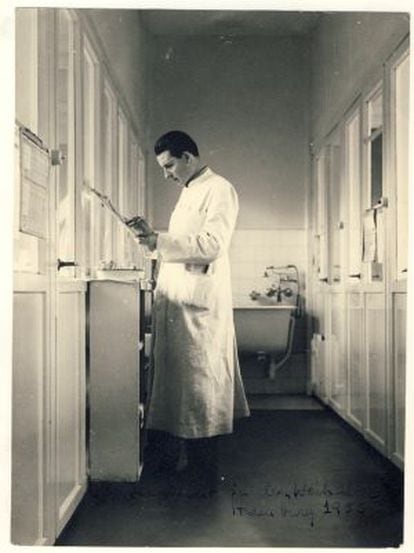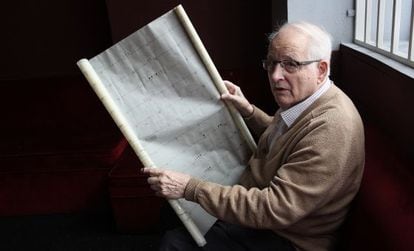The thalidomide detective
One scrupulous Spaniard played a key role in linking the drug to birth defects

"I don't want that prize that's handed out in Sweden, I just want the Guinness World Record for the cheapest, most efficient research ever," says Claus Knapp. The name might be deceiving, but Knapp is a Madrileño through and through. And the piece of research he is talking about is the one that uncovered the cause of the terrible malformations reported in newborns from 1959 onwards. Knapp and his colleague Widukind Lenz at Hamburg University Medical Center conducted the investigation jointly, although it was Lenz who ultimately got sole credit for it. "I don't mind. I was expecting a child and I just wanted to get back to Spain," says Knapp.
Now 85, Knapp produces a photograph of one of those limbless babies. "They were horrible cases: children born without arms or legs. This one died after 11 days."
"When I started getting the first cases, I thought, 'We need to do something about this.' After consulting with Lenz and with their boss, they got down to work. They took a little over three weeks to make their discovery. Exactly 52 years have now passed since then. On Monday, a Madrid court held the final session in the ongoing trial against German pharmaceutical firm Grünenthal over the sale of thalidomide in Spain.
Knapp and Lenz saw over 500 cases during the course of their research. In the evening, after leaving the medical center, they visited the mothers of affected infants. "It was very tough, they were distraught," he remembers. The researchers soon ruled out genetics as the cause of the deformations. "The cases were cropping up in families with no history of it. And there was no precedent for this: we only found one similar case in a book of drawings made in 1806 by Geoffroy Saint-Hilaire."
While my wife distracted the nurse, I found the confirmation"
The first two weeks were fruitless. "We drew up very extensive case histories. We asked the women all sorts of questions, from what they had eaten to what desserts they had bought. But it was all for nothing." They also asked about any medication the mothers might have taken while pregnant. "Physicians started to hate us because we would show up and ask for a patient's medical records and it became obvious that everyone was doling out medication without bothering to write it down."
Finally, one of those visits afforded them a definitive clue. "We went to a couple's house. He was a psychologist who had taken comprehensive notes of every aspect of the pregnancy. And he was adamant, 'This is because of the thalidomide; it's the only thing she's taken," Knapp recalls him as saying. "We had already visited around 20 homes and none of the women had mentioned it. But this man seemed very sure of himself. Lenz and I looked at each other, and that is when I made what I consider my greatest contribution to our research work. I said, 'We need to start over'."
The pair went back to see the women they had already visited. "We didn't want to ask them about thalidomide directly, because people might have said that our research was directed. We wanted them to be the ones to tell us about it."
It was not easy. One of the first women they went back to remembered her neighbor had given her something for her headaches. So they went to see her as well. "This woman worked at a valve factory. [...] She told us that the factory workers sat in a circle and that there was a fruit bowl in the middle, full of pills. Since they needed to concentrate so much on their work they all got headaches, and each woman would simply grab as many pills from the bowl as she liked. That is how thalidomide made it into her house."
We showed the drug company the work, but they didn't believe it"
Slowly, the cases were all confirmed. In an article written in 1962, Lenz and Knapp described several situations in which it was not enough to simply ask the mother. For instance, there was the case of a baby boy born on September 18, 1961. "His parents assertively claimed that the mother had taken no sedatives or tranquillizers whatsoever during her pregnancy. But a box left behind in a travel kit that doubled as the family medicine cabinet contradicted that version of events."
"In another case the mother did not remember that she had been hospitalized for appendicitis. She thought it had happened before the pregnancy. She received thalidomide while she was hospitalized," says Knapp. "In another home, the box was hidden in a separate drawer from the other medication. The grandmother had advised her pregnant daughter not to tell her husband that she was taking something for her nerves. It was frowned upon.

"There was this other woman who kept denying she had taken anything. But we had to confirm this case, too. So one day my wife and I went to the hospital where she'd given birth, and while my wife distracted the nurse, I fished around in the woman's medical records, and there it was!"
After that, they structured their findings statistically, and a pattern immediately emerged: all the mothers of deformed babies had taken thalidomide between days 37 and 50 of their pregnancy.
"But the worst still lay ahead: telling the lab about it," recalls Knapp. Their boss said: "You need to call Grünenthal. But don't do it alone. Bring someone from the center as a witness."
Knapp made the call. "I politely told them we had well-founded suspicions that their drug was causing their malformations. There was a click, and a lawyer got on the line. They must have already been suspecting it. Grünenthal is a very powerful lab, so we told them to come over and we'd give them our data. They showed up with three lawyers. The university gave us one. We showed them the work, but afterwards they called us and said they didn't believe it."
The firm then tried to take the original documents away. Knapp thought it wanted to know the mothers' identities to pressure them into changing their story. He never let it have the names.
"There were detectives all around us. We decided we had to make a lot of noise. We started telling our colleagues, and more cases started pouring in. In the end, 17 days later, the lab pulled the drug from the market. Who knows how many children were born nine months later with deformations that could have been prevented! We counted at least four."
The lab still tried to disqualify their work, and a media war ensued in which Knapp's mother, a journalist in Berlin, played a key role. Soon Knapp's own son was born: "He could have been one of the thalidomide children."










































